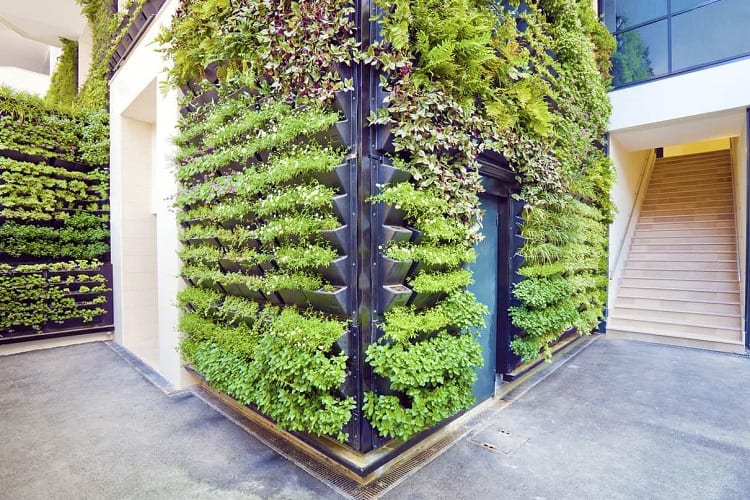If you don’t have a garden but you have a rooftop, you can easily turn it into your own natural sanctuary! You could fill it with a variety of plants and even grow your own veggies.
Why are rooftops great places for gardens?
Rooftops tend to get a lot of sun for many hours in a day, so that makes them a perfect spot, especially for plants that crave lots of direct sunlight.
Let’s explore some ideas for rooftop gardens that will completely transform your space. We’ll also look at what types of plants tend to grow best on rooftops.
If you’d like to see a graphical breakdown of the rooftop garden ideas, we got you covered:

Share this Image On Your Site
Table of Contents
Fantastic Ideas For Rooftop Gardens
Use Vertical Space

If you don’t have a lot of space in your rooftop garden, remember that you can make use of vertical space, such as walls. These are the perfect places to hang planters, install green walls, or grow climbers.
Create Raised Beds

Having raised flower or veggie beds in your rooftop garden is a great way to make use of space while also finding it easier to tend to your plants because you won’t have to bend down to care for them.
Just make sure that your roof can handle their weight. You can reduce their weight by making use of containers such as repurposed buckets or recycling bins. Just make sure they have adequate drainage, such as with holes drilled into the bottom of them.
Grow Larger Shrubs And Trees

If you have the space at your disposal, consider growing taller plants and trees. This is a wonderful way to really feel like you’re setting up a garden in the sky. It will also give you more privacy.
On that note, some excellent green choices to boost your privacy include bamboo and grasses.
Create Some Walkways

This can turn your garden into a spectacular sanctuary, but walkways are especially a great idea if you’re growing rows of vegetables in your rooftop garden.
Setting up walkways between your garden beds will help make it easier for you to tend to your produce. Make sure you line the walkways with soft cedar mulch to give them a beautiful appearance.
Divide The Space

Whether you’re short on space or just aren’t sure about how to prevent your rooftop garden from looking cluttered, an easy solution is to divide the space into two, three, or more sections.
You could have one space that’s for sitting and socializing, one space for veggies, and another for shrubs, for instance. Place pots and planters strategically to create boundaries between these spaces so that your garden looks more organized and harmonious.
Make Use Of Pots

You don’t have to worry about raised beds if that feels like too much work for you. Using lots of pots will be a fantastic take on the rooftop garden design.
But, take this design one step further by using drip irrigation systems so that you can water your plants without having to do so manually every day. The containers you use for your plants should be well-draining options so that water doesn’t accumulate in them.
When choosing the right pots, make sure they have wide bases. This will ensure that they don’t topple over in the wind.
Install A Rooftop Lawn

You might not think you can have a lawn on your rooftop but you can – as long as you’re up for a bit of effort and your building is allowed to have one.
To create your own rooftop lawn, you’ll have to put down several layers of repellent and insulation before you can go ahead and install the grass so that you protect the roof against mold and leaks. Mix native grass with moss and sedums. This will ensure that the lawn is green for most of the year, as SFGate reports.
What Plants Grow Best In A Rooftop Garden?
While you might think the bright sunshine that streams into your rooftop garden combined with the excellent air circulation up there means that you can plant anything on your rooftop, you do need to be careful.
Some plants won’t be able to deal with the sun or wind, which could wick away moisture from the plants, so make sure you choose the best rooftop plants. These include the following:
- Plants that have fuzzy leaves help them to reduce water evaporation. The fuzziness of their leaves also helps to reflect sunlight off the plant. Examples of such plants include sage and lamb’s ears.
- Plants that have tap roots. These store water reserves in their roots, so they won’t dry out easily. Examples include coneflowers.
- Plants that can tackle heat and drought conditions, such as succulents.
- Plants that are evergreen. These are also heavily resistant to drought, plus they will give your rooftop a beautiful appearance all year round. Choose evergreens such as Junipers and Oregon Grape.
Related Questions
This is best avoided as it can be too heavy while giving rooftop plants poor drainage. Rather choose lightweight artificial soil called soilless mix, as Garden Design reports. This makes use of organic matter, such as coco coir, slow-release fertilizer, and peat.
Heavy wind could be the culprit. Invest in lattice or wood screens to block some of the wind. These screens can also help to offer your plants a little bit of shade if they require it.
Conclusion
You want to have a thriving garden, so why not put it on the roof?
Even if you don’t have a lot of space for it, a rooftop garden can help you to grow beautiful and healthy plants as well as veggies. It’s a fantastic way to enjoy a creative garden while making sustainable use of your rooftop space.

